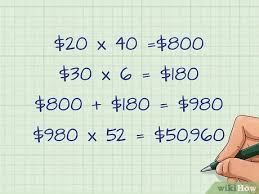In today’s economy, understanding how much you can earn annually based on an hourly wage is crucial for financial planning and decision-making. Many individuals, whether employees or freelancers, rely on hourly rates to determine their yearly income potential. This article dives into the specifics of calculating annual income at a rate of $22 per hour, exploring different scenarios and considerations that affect the final figure.
Table of Contents
ToggleOverview of Hourly Wages and Annual Income
Hourly wages form the foundation of compensation for many workers across various industries. Unlike salaried positions where income is fixed regardless of hours worked, hourly wages directly correlate with the time spent working. For someone earning $22 per hour, the calculation of annual income hinges on factors such as the number of hours worked per week and whether the work schedule includes overtime or benefits such as paid time off.
Basic Calculation: Annual Income Based on Full-Time Employment
To begin, let’s consider a standard full-time work schedule in the United States, which typically involves 40 hours per week. Using this as a baseline:
Hourly wage×Hours worked per week×Weeks worked per year=Annual income\text{Hourly wage} \times \text{Hours worked per week} \times \text{Weeks worked per year} = \text{Annual income}Hourly wage×Hours worked per week×Weeks worked per year=Annual income
For an individual earning $22 per hour:
22 dollars/hour×40 hours/week×52 weeks/year=$45,760 per year22 \, \text{dollars/hour} \times 40 \, \text{hours/week} \times 52 \, \text{weeks/year} = \$45,760 \, \text{per year}22dollars/hour×40hours/week×52weeks/year=$45,760per year
This straightforward calculation assumes consistent hours without overtime or breaks in employment throughout the year.
Adjustments for Part-Time Work
Many workers do not maintain a full-time schedule and instead work part-time hours. In such cases, the annual income calculation adjusts proportionally based on the number of hours worked each week. For instance, someone working 20 hours per week at $22 per hour would earn:
22 dollars/hour×20 hours/week×52 weeks/year=$22,880 per year22 \, \text{dollars/hour} \times 20 \, \text{hours/week} \times 52 \, \text{weeks/year} = \$22,880 \, \text{per year}22dollars/hour×20hours/week×52weeks/year=$22,880per year
Understanding the impact of part-time versus full-time employment helps individuals gauge their expected income realistically.
Overtime and Additional Earnings
In some industries or jobs, employees earn overtime pay for hours worked beyond the standard 40-hour workweek. Overtime rates typically range from time-and-a-half (1.5 times the regular hourly rate) to double-time (2 times the regular rate). Factoring in overtime can significantly increase annual income. For example, if an employee works 50 hours per week with 10 hours of overtime:
Regular hours=40 hours/week×52 weeks/year=2080 hours/year\text{Regular hours} = 40 \, \text{hours/week} \times 52 \, \text{weeks/year} = 2080 \, \text{hours/year}Regular hours=40hours/week×52weeks/year=2080hours/year
Overtime hours=10 hours/week×52 weeks/year=520 hours/year\text{Overtime hours} = 10 \, \text{hours/week} \times 52 \, \text{weeks/year} = 520 \, \text{hours/year}Overtime hours=10hours/week×52weeks/year=520hours/year
Calculating income with overtime at time-and-a-half:
($22 per hour×40 hours/week+$33 per hour×10 hours/week)×52 weeks/year=$53,160 per year(\$22 \, \text{per hour} \times 40 \, \text{hours/week} + \$33 \, \text{per hour} \times 10 \, \text{hours/week}) \times 52 \, \text{weeks/year} = \$53,160 \, \text{per year}($22per hour×40hours/week+$33per hour×10hours/week)×52weeks/year=$53,160per year
This example shows how overtime significantly impacts annual earnings.
Considerations for Freelancers and Contract Workers
Freelancers and independent contractors operate under different financial models compared to traditional employees. They often negotiate rates per project or hour and may not have consistent work throughout the year. Therefore, estimating annual income for freelancers at $22 per hour involves considering factors such as billable hours, client availability, and overhead costs.
Tax Implications and Net Income
Understanding tax obligations is crucial when calculating actual take-home pay. Federal, state, and local taxes, as well as deductions for Social Security and Medicare, impact net income. While tax rates vary based on income level and location, estimating net income provides a clearer picture of financial resources available for living expenses and savings.
Conclusion
In conclusion, determining annual income based on an hourly wage of $22 involves straightforward calculations for full-time workers, adjustments for part-time schedules, considerations for overtime, and understanding tax implications. Whether you’re an employee, freelancer, or contractor, knowing your potential annual income helps in budgeting, financial planning, and setting personal financial goals. By mastering these calculations, individuals can make informed decisions about work opportunities and career paths, ensuring financial stability and growth in the long term.
3.5




